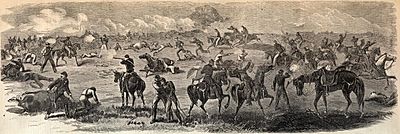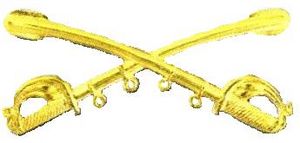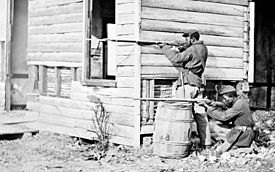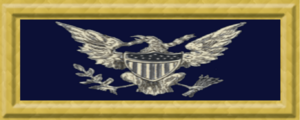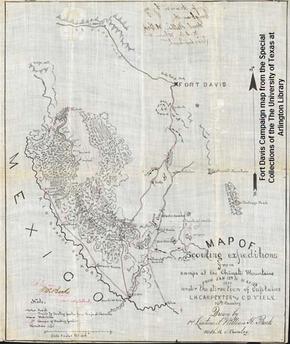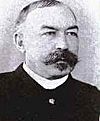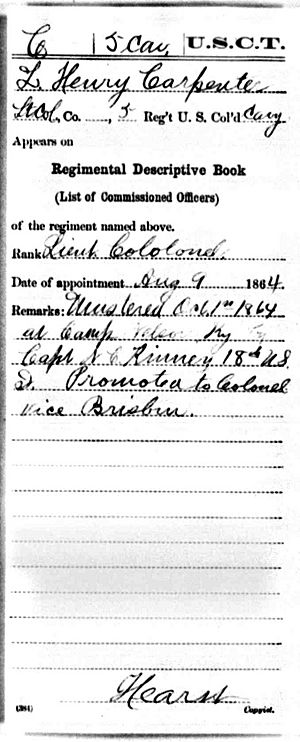Louis H. Carpenter facts for kids
Quick facts for kids
Louis Henry Carpenter
|
|
|---|---|
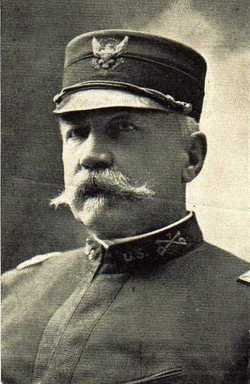
Brigadier General Louis H. Carpenter, 5th Cavalry
|
|
| Nickname(s) | L. Henry |
| Born | February 11, 1839 Glassboro, New Jersey, US |
| Died | January 21, 1916 (aged 76) Philadelphia, Pennsylvania, US |
| Place of burial |
Trinity Episcopal Church New Cemetery, Swedesboro, New Jersey
|
| Allegiance | |
| Service/ |
|
| Years of service | 1861–1899 |
| Rank | |
| Commands held | 5th US Colored Cavalry 1865–1866 1st Division, 3rd Corps at Chickamauga in May 1898 3rd Division, 4th Corps at Tampa, Florida later in 1898 Military Governor of the province of Puerto Principe, Cuba until June 1899. |
| Battles/wars | American Civil War
|
| Relations | James Edward Carpenter (brother) |
| Other work | writer and speaker |
Louis Henry Carpenter (February 11, 1839 – January 21, 1916) was a brave United States Army officer. He became a brigadier general and received the Medal of Honor. This special award was given for his heroic actions during the Indian Wars.
He left Dickinson College in 1861 to join the Union Army at the start of the American Civil War. He began as a private soldier but quickly became an officer. During the Civil War, he fought in at least 14 major campaigns. He served mostly with the 6th U.S. Cavalry. He also led the 5th U.S. Colored Cavalry Regiment. By the end of the war, Carpenter was a high-ranking officer. He was also made a first lieutenant in the regular United States Army.
Carpenter earned the Medal of Honor for his actions during the Indian Wars. He served with the Buffalo Soldiers of the 10th U.S. Cavalry. He was often praised for his bravery in official reports.
After the Civil War, he served on the western frontier until 1887. He fought against many Native American tribes and explored new territories. During the Spanish–American War, he led troops in Cuba. He became the first military governor of Puerto Principe, Cuba. After 38 years of service, he retired from the Army in 1899 as a brigadier general. Later, he became a writer and speaker.
Contents
- Early Life and Family History
- Military Service and Key Battles
- Retirement and Legacy
- Honors and Awards
- Images for kids
- See also
Early Life and Family History
Louis H. Carpenter was born in Glassboro, New Jersey. He was the oldest of eight children. His family moved to Philadelphia in 1843. He went to high school in Philadelphia and later attended the University of Pennsylvania.
His younger brother, James Edward Carpenter, also served in the Union Army. He started as a private and rose to the rank of major.
Military Service and Key Battles
Serving in the Civil War
In July 1861, Louis Carpenter left college to join the "Fighting Sixth" Cavalry Regiment. He became a private in the Union Army. This army was later known as the Army of the Potomac. Carpenter was trained as an infantry soldier. He also learned to ride a horse to battle and scout. In the early part of the war, learning to be a "horse soldier" was tough.
The Union cavalry grew very fast in the East. At first, officers were chosen by soldiers or through politics. This led to many leaders who were not very good. But over time, the Union "horse soldiers" became skilled cavalry troopers. They learned to fight well, both on foot and on horseback. They used carbines, pistols, and sabers.
After the Seven Days Battles in 1862, Carpenter became a second lieutenant. He earned this rank for his brave actions and leadership.
The Gettysburg Campaign
The Gettysburg Campaign included many fights before and after the main Battle of Gettysburg. Carpenter played an important role in these battles. He was a company commander and later an executive officer.
Here are some of the battles the 6th U.S. Cavalry fought in June and July 1863:
- Battle of Brandy Station, Virginia, June 9.
- Battle of Middleburg, Virginia, June 21.
- Battle of Upperville, Virginia, June 21.
- Battle of Fairfield, Pennsylvania, July 3.
- Williamsport, Maryland, July 6.
- Funkstown, Maryland, July 7 and 10.
- Battle of Boonesboro, Maryland, July 8 and 9.
Battle of Brandy Station
On June 9, 1863, Union and Confederate cavalry forces met at Brandy Station, Virginia. The Confederate cavalry, led by Major General J.E.B. Stuart, was surprised. Union forces, including Carpenter's Company H, attacked them. This was the largest cavalry battle of the Civil War at that time. It showed that Union horse soldiers were just as good as their Southern enemies.
Battle of Fairfield
On July 3, 1863, Union General Wesley Merritt heard about a slow Confederate wagon train. He sent the 6th U.S. Cavalry, led by Major Samuel H. Starr, to find it. This led to the Battle of Fairfield.
Carpenter's troops dismounted and set up defenses. They fought off a charge from the 7th Virginia Cavalry. The Confederates attacked again, pushing back the Union forces. Major Starr was wounded and captured. Carpenter and a small group of the 6th Cavalry regrouped. They made the Confederates think a larger Union force was coming.
The 6th Cavalry's stand at Fairfield was very brave. It helped the Union effort around Gettysburg. Even though the regiment suffered heavy losses, their strong fight delayed the Confederates. This prevented them from causing serious problems for the Union Army.
Lieutenant Carpenter was one of only three officers from the 6th U.S. Cavalry to escape the fight at Fairfield. Private George Crawford Platt in Carpenter's company later received the Medal of Honor. He saved the regimental flag during the battle. Carpenter himself was promoted for his brave actions at Fairfield.
Overland Campaign and Sheridan's Raids
In April 1864, Major General Philip Sheridan took command of the Cavalry Corps. Carpenter became his Aide-de-camp, like an executive assistant. Carpenter may have influenced Sheridan's idea to use cavalry for long-distance raids.
In May 1864, Sheridan convinced General Ulysses S. Grant to let his cavalry operate on its own. The Battle of Yellow Tavern was the first of these raids. It was a clear Union victory. Confederate Major General J.E.B. Stuart was killed in this battle. Carpenter was promoted to first lieutenant in the regular army in September 1864. He then joined the United States Colored Troops.
Leading the 5th U.S. Colored Cavalry
In October 1864, Lieutenant Colonel L. Henry Carpenter arrived at Camp Nelson, Kentucky. He was to help organize the 5th United States Colored Cavalry (USCC). Most of the men were formerly enslaved African Americans.
First Battle of Saltville
In September 1864, Union forces attacked the salt works near Saltville, Virginia. This was the First Battle of Saltville. The attack failed, and wounded soldiers were left behind. Reports of bad treatment towards "colored troops" and their white officers spread.
Challenges and Solutions
Carpenter became the executive officer of the 5th USCC. He was in charge of training the African-American recruits. A big problem was that most of the men could not read or write. This made it hard to find non-commissioned officers. Carpenter solved this by placing literate white officers among the "colored sergeants." He also started a reading program for the African-American NCOs.
Another challenge was the rifles given to the 5th USCC. They were muzzle-loaded Enfield infantry rifles. These were not good for fighting on horseback. Carpenter taught his men to fight dismounted, like "mounted infantry."
Stoneman's 1864 Winter Raid
In December 1864, the 5th USCC joined a raid into southwestern Virginia. They fought in several battles, including the Battle of Marion and the Second Battle of Saltville.
During the Battle of Marion, Carpenter and his commander led their soldiers forward. They faced heavy fire from Confederate cannons. Carpenter rallied his men when they fell back. They charged again but could not break the enemy lines. Carpenter later led a rescue force to save white soldiers trapped near a bridge.
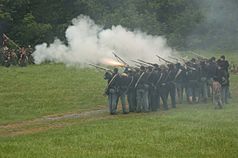
The next day, the battle continued. Union forces broke through the Confederate lines but were pushed back. Carpenter's men tried to retreat in order. Many "colored soldiers" broke ranks to save their wounded friends. Union reinforcements arrived and helped stabilize the line. The Confederates ran out of ammunition and retreated. This costly victory was a high point of the raid.
On December 20, Union forces attacked Saltville again. The 5th and 6th USCC fought fiercely. The Confederates were outnumbered and retreated. Union forces tried to destroy the salt works. They damaged some parts but failed to destroy the actual salt wells. Carpenter later wrote about how his men responded in this battle.
Ambush at Simpsonville
On January 23, 1865, 80 "colored" troops were moving cattle. Near Simpsonville, Kentucky, they were ambushed by Confederate guerrillas. Many Union troops could not fire their rifles because of bad powder. The guerrillas had revolvers. Most of the "colored soldiers" were wounded or dismounted. Only two escaped by hiding or pretending to be dead.
Local citizens found 15 dead and 20 wounded soldiers. Many more died later from their wounds or the cold. Carpenter immediately sent ambulances and an escort. He wrote a report and pushed for the guerrillas to be caught.
Commanding the 5th USCC
In February 1865, Carpenter took command of the 5th USCC Regiment. The regiment served in Kentucky and Arkansas. They performed guard duties and hunted rebel renegades.
End of the Civil War and Reconstruction
Carpenter fought in at least 14 campaigns and over 150 battles during the Civil War. After the war, he stayed in Arkansas with the 5th USCC until March 1866.
During Reconstruction, the military oversaw local government. They helped formerly enslaved people vote. They also tried to protect officials and freedmen from violence. Carpenter and his men faced some hostility but worked to keep the peace. Carpenter was promoted to colonel of volunteers in November 1865.
Battles of the 5th USCC (1864-1865)
Here is a summary of the 5th USCC battles where Carpenter was present:
- 1864:
- October 2 – Saltville, Virginia – Battle of Saltville I
- December 12 – Hopkinsville, Kentucky – an engagement
- December 13 – Kingsport, Tennessee (flanking movement & skirmishing)
- December 17–18 – Marion, Virginia – Battle of Marion
- December 20–21 – Saltville, Virginia – Battle of Saltville II
- 1865:
- January 25 – Simpsonville, KY – an ambush
Retirement of the 5th USCC
The 5th USCC had its final review on March 16, 1866. Many officers, including Carpenter, were honorably discharged. The regiment was officially retired on March 20, 1866. Carpenter then returned home to Philadelphia. After his leave, he joined the new 10th United States Cavalry Regiment.
Indian Wars and Frontier Service
The Buffalo Soldiers: 10th Cavalry Regiment
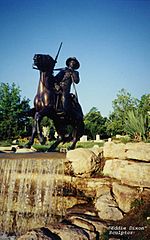
After the Civil War, Carpenter volunteered for cavalry duty with "Negro Troops." The 10th U.S. Cavalry was formed in 1866 at Fort Leavenworth, Kansas. It was an all African-American regiment. The fort's commander made life hard for the new troops. So, the regiment moved to Fort Riley, Kansas.
Carpenter became a captain in the regular army in July 1866. He took command of Company D, 10th U.S. Cavalry. He later commanded Company H. He served with these original "Buffalo Soldiers" for 13 years. They often fought Native Americans in the southwest United States. Carpenter went to Philadelphia to recruit non-commissioned officers. His efforts brought in many experienced soldiers for the 10th Cavalry.
Carpenter's men respected him. His company had a very low desertion rate. He was known for being fair and firm. He understood the hardships and racism his men faced. After his service, he defended the Buffalo Soldiers' actions and abilities. His leadership set a high standard for all cavalry units.
Battle of Beecher Island
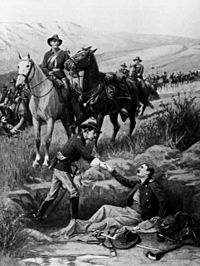
A soldier offers aid to his wounded comrade after the Battle of Beecher Island. The Harper's article states that this is "Bvt. Col. Louis H. Carpenter greeting Lt. Col. G. A. Forsyth" who was twice wounded by gunfire and who had fractured his leg when his horse fell. Notice officer shoulder boards.
On September 17, 1868, Lieutenant Colonel George Alexander Forsyth and 48 white scouts were attacked. They were on a sand island in the Republican River. This fight became the Battle of Beecher Island. The attackers were mostly Cheyenne and Arapaho warriors. Forsyth sent two scouts to get help from Fort Wallace.
Three rescue parties went out. The first, led by Lieutenant Colonel Carpenter with Troops H and I of the 10th Cavalry Regiment, reached Forsyth on September 25. Forsyth was badly wounded and not expected to live much longer.
Battle of Beaver Creek
Two weeks later, Carpenter was ordered out again. Troops H and I of the 10th Cavalry were escorting Major Carr to Beaver Creek with supplies. Near there, Carpenter's group was attacked by about 500 Native American warriors.
Carpenter quickly formed his supply wagons into a circle for defense. His mounted troopers fought a delaying action. On his command, his men rushed inside the wagon circle. They dismounted and set up a firing line.
Carpenter's men fired many shots from their Spencer repeating rifles. The shots hit the first waves of mounted warriors. Many warriors died. Only three made it close to the wagons before they were killed. The Native Americans were so shocked by Carpenter's defense that they did not attack again.
Carpenter's troopers then sent scouts to find the 5th Cavalry. They returned to Fort Wallace on October 21. Carpenter's command had traveled far, defeated many warriors, and delivered supplies. For their bravery at Beaver Creek, the "Buffalo Soldiers" were praised by General Sheridan. Captain Carpenter was promoted to Colonel. In 1898, Carpenter received the Medal of Honor for his actions in September and October 1868.
Defending the Wichita People
In 1869, the 10th Regiment moved to Camp Wichita, Indian Territory (now Oklahoma). Carpenter and the 10th Cavalry were ordered to build a new military post there. This post later became Fort Sill.
On June 12, 1869, Camp Supply was attacked by Comanche raiders. Carpenter and his troops flanked the Native Americans, forcing them to retreat.
In August 1869, Carpenter and his troopers faced a fierce attack by Kiowa and Naconee Indians. These groups wanted to destroy the Wichita settlement on the Anadarko Reservation. Carpenter's Troops H and L patrolled the area. They fought several groups of warriors who were setting prairie fires. Carpenter's troopers also charged and routed over 150 warriors who were trying to get behind the defenders.
Satank, Satanta, and Big Tree
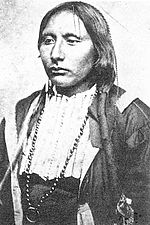
In May 1871, Carpenter helped capture and escort three important Kiowa leaders: Satank, Santana, and Big Tree. These leaders were tried in a United States civil court for raids and murder. This was different from a military court.
Defense of the Wichita II
In August 1874, Carpenter fought at Anadarko Reservation again. This was during the Red River War (1874–75). Carpenter and his troops supported Fort Sill. They patrolled and fought several Kiowa and Comanche raiding parties. The peaceful Wichita Indians were being targeted by hostile tribes.
Victorio Campaign and Mapping the Frontier
Carpenter was very involved in the Victorio Campaign of 1879–80. Victorio was a brave chief of the Chihenne band of the Chiricahua Apaches.
From January to May 1880, Carpenter led scouting missions into the Chinati Mountains. This area was near the border with Mexico. Victorio and other Apaches had been raiding there. These scouts helped create the first good maps of the area. Finding waterholes and mapping the land was very important for the campaign.
On May 12, 1880, Apaches attacked a wagon train. Captain Carpenter and H Company chased them to the Rio Grande. Carpenter had to stop at the Mexican border.
Rattlesnake Springs Battle
On August 6, 1880, Colonel Grierson and the 10th Cavalry reached Rattlesnake Springs. They had marched over 65 miles in 21 hours. Grierson set up an ambush. Carpenter and his two cavalry troops arrived as reinforcements.
Victorio and his Apaches approached the springs. They sensed danger and stopped. The soldiers opened fire. Victorio's men scattered. They needed water badly, so they attacked again. Carpenter charged forward with his companies. Their carbines fired many shots, scattering the warriors. The Native Americans were shocked by the strong force. Victorio tried repeatedly to reach the spring but failed. He and his followers retreated into the mountains. Carpenter pursued them until dark.
The next day, Carpenter and Captain Nicholas M. Nolan headed to Sulfur Springs. They wanted to prevent the Apaches from getting water there. Victorio's warriors attacked a wagon train carrying supplies. Carpenter and two companies charged to the rescue. The Apache attack broke apart, and the warriors fled.
Chasing Victorio
On August 9, Texas Rangers found Victorio's main camp. The Rangers joined Carpenter in the attack. Carpenter's attack scattered the guards. The troopers captured cattle, supplies, and pack animals. Victorio was running low on food and water. He began to head south. Carpenter pursued him, but the horses were tired. Carpenter divided his command. Nolan took one route, and Carpenter took another. On August 13, Nolan reached the Rio Grande. Indian scouts reported Victorio had crossed into Mexico.
On October 14, 1880, a Mexican Army sharpshooter killed Victorio in Mexico. His sister, Lozen, continued fighting. She was captured in 1886 by Buffalo Soldiers of the 9th Cavalry.
Carpenter and other officers of the 10th Cavalry mapped over 34,420 miles of unknown land in West Texas. They added new roads and telegraph lines. These scouting trips were done in harsh weather with limited supplies. They also had to be ready for attacks from Apaches and bandits. Carpenter's maps showed important water holes, mountain passes, and grazing areas.
First Fort Commands
From 1878 to 1879, Carpenter was the Commanding Officer of Fort Davis. He was a captain in the Regular Army but also a colonel in the 10th Cavalry. He later commanded the fort again in 1879. Carpenter was then transferred to the 5th Cavalry and promoted to major in 1883.
On July 4, 1888, at Gettysburg, Carpenter was questioned for being absent the day before. He proved his absence was due to a mix-up with the Secretary of War. Carpenter was on duty for the 25th anniversary of the Battle of Gettysburg.
Later Career and the Spanish–American War
Carpenter became the first Director of the "Cavalry and Light Artillery School" at Fort Riley, Kansas. He was a lieutenant colonel in the 7th Cavalry from 1892 to 1897. This school taught officers and men how to be good soldiers. He also led the board that updated cavalry tactics for the U.S. Army.
In 1891, the Army tried to include Indian soldiers in regular units. This was to give them jobs and use their warrior skills. Many were sent to the "Cavalry School" at Fort Riley. They learned cavalry tactics, hygiene, and English. But the experiment failed due to language problems and discrimination. Carpenter had chosen Lieutenant Hugh L. Scott to lead Troop L, made of Kiowa, Comanche, and Apache Indians. This troop was known for its good behavior.
Carpenter was promoted to lieutenant colonel in 1892 and then to colonel in 1897. In May 1898, he became a brigadier general of volunteers for the Spanish–American War.
General Carpenter commanded divisions at Chickamauga and Tampa, Florida. Later, he went to Cuba to occupy the Province of Puerto Principe. His troops were the first to be stationed in Cuba after the Battle of Santiago de Cuba. Carpenter was appointed Military Governor of the province. He served until June 1899. He then returned to his regular army rank of colonel. Colonel Carpenter was promoted to brigadier general in October 1899. He retired the next day, after 38 years of honorable service.
Retirement and Legacy
After retiring, General Carpenter returned to Philadelphia. He never married or had children. He finished a book his father started about their family history. He also wrote about his Civil War service and time on the Western Frontier. His writings on the May 1864 Richmond Raid, where Confederate General J.E.B. Stuart was killed, are still used today. He gave many talks and wrote articles for the G.A.R. (Grand Army of the Republic), a group for Union Army veterans.
Brigadier General Carpenter passed away on January 21, 1916, at his home in Philadelphia. He was buried in the family plot at Trinity Episcopal Church New Cemetery, Swedesboro, New Jersey.
Honors and Awards
During his military career, Carpenter received the Medal of Honor for his bravery in the Indian campaigns. He was also promoted for his courage and mentioned in official reports during both the Civil War and the Indian campaigns.
Military Promotions
Regular Army Ranks
- Private: July 1861, Company C, 6th US Cavalry
- Corporal: November 1, 1861, Company C, 6th US Cavalry
- Sergeant: February 1862, Company L, 6th US Cavalry
| Brigadier general |
|---|
| O-7 |
|
|
| October 19, 1899, HQ, Washington, D.C. |
| Colonel | Lieutenant colonel | Major | Captain | First Lieutenant | 2nd lieutenant |
|---|---|---|---|---|---|
| O-6 | O-5 | O-4 | O-3 | O-2 | O-1 |
|
|
 |
 |
 |
|
|
| June 2, 1897, F&S, 5th US Cavalry | July 28, 1892, F&S, 2nd US Cavalry | February 17, 1883, F&S, 5th US Cavalry | July 28, 1866, Company H, 10th US Cavalry | September 28, 1864, F&S Cavalry Corps | July 17, 1862, Company L, 6th US Cavalry |
Special Promotions for Bravery (Brevets)
Carpenter received several special promotions, called brevets, for his bravery and excellent service. These included promotions to:
- First lieutenant on July 3, 1863, for his actions at Gettysburg.
- Captain (United States) on September 19, 1864, for Winchester, Virginia.
- Major (United States) on March 13, 1865, for gallantry.
- Lieutenant colonel (United States) on March 13, 1865, for his service during the Civil War.
- Colonel (United States) on October 18, 1868, for his actions at Beaver Creek, Kansas, during the Indian Wars.
U.S. Volunteers Ranks
- Lieutenant colonel on October 1, 1864, 5th US Colored Cavalry (USCC)
- Colonel on November 2, 1865, 5th USCC
- Brigadier general on May 4, 1898, 1st Corps, 3rd Division
Known Commands and Leadership Roles
- Led the 5th US Colored Cavalry Regiment from 1865 to 1866.
- Commander of Fort Davis in West Texas from 1878 to 1879.
- Commander of Fort Robinson, Nebraska in 1887.
- Commander of Fort Myer, Virginia from 1887 to 1891.
- Director of Cavalry School Application, Fort Riley, Kansas in 1892.
- Appointed to revise cavalry tactics in 1896.
- Commander of Fort Sam Houston, Texas from 1897 to 1898.
- Commander of 1st Corps and 3rd Division, then 4th Corps in the Spanish–American War in 1898.
- Military Governor of the Province of Puerto Principe (now Camagüey Province), Cuba from 1898 to 1899.
Memberships and Clubs
- Member of the Loyal Legion
- Veteran of Foreign Wars
- Historical Society of Pennsylvania
- Academy of Natural Sciences
- Union League
Images for kids
See also
- List of Medal of Honor recipients for the Indian Wars
- List of people from Colorado
- List of people with surname Carpenter



